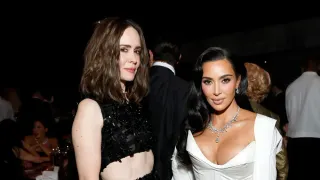
5 hours ago
Benson Boone’s Gym Selfie: Why Thirst Traps Matter (and Don’t) in Queer Culture
READ TIME: 18 MIN.
Benson Boone—whose hit single “Beautiful Things” has been echoing through queer playlists and TikTok feeds all year—recently turned up the heat with a gym selfie so steamy it practically fogged up Instagram’s servers. Sporting a shredded six-pack and a glint of self-aware mischief, Boone’s moment of self-exposure quickly became the talk of social media, drawing waves of heart emojis, fire GIFs, and, yes, a flurry of “Daddy?” comments from LGBTQ+ fans and allies alike. For queer audiences, the moment is more than just a celebration of aesthetics; it’s a lens into the evolving relationship between pop stardom, body politics, and the complicated dance of desire and identity in the digital age .
Benson Boone shares new photo with his friend at the gym. pic.twitter.com/mpTlifNQBr
— Pop Tingz (@ThePopTingz) October 30, 2025
Boone’s rise has been meteoric: after his breakout on “American Idol” and the release of his debut album, he’s been compared to everyone from Harry Styles to Justin Bieber—comparisons he doesn’t exactly relish. “I don’t want to be the same as Harry Styles… I’m Benson Boone! I’m completely different,” he told Rolling Stone, brushing off the endless parade of popstar parallels . For Boone, the pressure to live up to the “sex icon” label is loaded, especially when every shirtless photo can spark a thousand memes, fan edits, and thinkpieces.
But for queer fans, Boone’s gym selfie isn’t just eye candy—it’s a familiar script with a contemporary twist. Pop history is littered with straight (and straight-presenting) male stars whose bodies became sites of both adoration and projection for LGBTQ+ people seeking glimpses of queerness in the mainstream. Boone himself admits he was a closeted fan of male pop icons growing up, secretly obsessing over Bieber and One Direction videos with a friend, never daring to let on just how much he cared . “Honestly, I was probably a bigger fan of them than any of my sisters,” Boone confessed. “But, again, you know, we would never tell anybody.”
The full-circle irony isn’t lost on anyone: now Boone is the object of thirst, not just the fan. And for many LGBTQ+ viewers, that role reversal carries a bittersweet resonance—a reminder of both the longing for and the hazards of queer male visibility in pop culture.
Of course, the discourse machine never sleeps. Boone’s gym selfie immediately sparked debates about “queerbaiting”—that slippery term for when straight celebrities flirt with homoerotic aesthetics, knowingly or not, to court queer attention. Out Magazine’s commentary was quick to clarify: “Real people, like Benson Boone, are just existing. They’re not queerbaiting you. They happen to be hot, and it looks like many of you fell into the thirst trap” .
But the hunger for representation—and the frustration when it feels tantalizingly out of reach—remains palpable. For decades, queer fans have had to decipher coded gestures, ambiguous glances, and carefully curated social media posts, parsing what might be authentic self-expression from what might be marketing strategy. Boone’s selfie, intentionally or not, sits right in the crosshairs of these cultural anxieties.
Yet Boone himself offers a more vulnerable perspective. Despite the relentless attention to his looks, he says the “sex symbol” label is not one he’s comfortable wearing. “When I start to think about my appearance too much, it just kills me, because there’s always something more I could do,” he told Rolling Stone. “There’s always a hairstyle or, like, my arms could be bigger. My shoulders could be bigger. It’s never-ending.” For Boone, working out is about feeling strong, not just looking hot—and the public’s obsession with his body can sometimes feel more like a burden than a blessing .
In a cultural moment where body positivity and authenticity are prized but deeply fraught, Boone’s candidness about his insecurities is itself a kind of radical transparency. For LGBTQ+ people—especially queer men, transmasculine, and non-binary folks—navigating the minefield of body image, desire, and self-worth is a daily reality. Social media, with its endless scroll of idealized physiques, can be both a source of inspiration and a trigger for comparison and dysphoria.
Boone’s willingness to name these pressures, even as he participates in the spectacle, is a reminder that thirst traps are rarely just about sex appeal; they’re about who gets to feel beautiful, who gets to be desired, and who gets to tell their own story. His complicated relationship with religion and sexuality—growing up Mormon, leaving the faith, and wrestling with the expectations around masculinity—mirrors struggles familiar to many queer people . As one fan put it on Twitter, “Seeing someone as mainstream as Benson Boone talk about not fitting the mold? That’s the real glow-up.”
So, does Benson Boone’s gym selfie matter? For some, it’s just another hot guy flexing for the algorithm. But for others—especially queer youth navigating their own identities in a world that still polices how bodies should look and love—it’s a small but meaningful disruption. It’s proof that even in the most mainstream corners of pop culture, questions of authenticity, desire, and self-acceptance are never far from the surface.
And if that selfie inspires a few more people to hit the gym, post a thirst trap of their own, or just feel good in their skin, then maybe that’s something to be proud of—abs or no abs.






